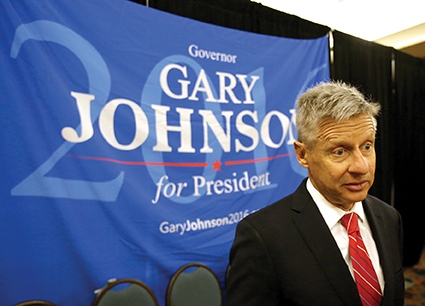A View to the US: Third Party Rising
As of mid-August, the 2016 US Presidential Election appears to be veering towards Hillary Clinton. Polls have indicated rising support for her candidacy since last month’s Democratic Party convention. Meantime, Donald Trump’s quest has been heading in the opposite direction. A series of controversial quotes have several officials within the Republican Party wondering whether Mr. Trump has the temperament and discipline to wage an effective campaign. Whereas Ms. Clinton has seemingly consolidated the Democrats intra-party differences (namely Bernie Sanders’ insurgency), Republicans are far from united. A significant group of party stalwarts have declared they won’t actively help Mr. Trump, essentially conceding Hillary Clinton will be America’s next President. Their focus is being directed towards “down ticket” legislative contests that seek to retain Republican control of the Congress and Senate.
This has been a very unpredictable year however. Surveys show that a record percentage find Trump and Clinton untrustworthy and are looking at third party candidates as alternatives. In light of this sentiment, the Libertarian and Green Parties are attracting voter interest. Recent polling averages show nearly thirteen percent support for both of these parties. Given the tepid attitude towards Trump, Clinton and the overall Presidential nominating process, this figure will likely grow.
In US political terms, voting third party is basically perceived as a protest and therefore wasted ballot. Nevertheless it has influenced the outcome of recent Presidential contests. Ross Perot (whose 1992 campaign somewhat resembles Mr. Trump’s run) garnered a significant percentage of votes that were a major factor in Bill Clinton’s victory. Then-Green Party candidate Ralph Nader’s 2.5 percent tally in the state of Florida was considered the key determinant which allowed George H.W. Bush to become President in the contentious 2000 general election. The 2016 race is potentially becoming another situation where the final outcome could be influenced by a non-major party’s performance.
Gary Johnson, the Libertarian Party’s candidate, has been receiving increased media scrutiny. His polling numbers average around nine percent. It’s widely assumed that Mr. Johnson is gaining votes at the expense of the Trump campaign. According to a July CNN survey, seventeen percent of Republican voters who didn’t support Mr. Trump during that party’s primaries will now back Mr. Johnson. In contrast, only four percent of the Democratic Party’s electorate reject Hillary Clinton’s nomination and will go Libertarian.
In several respects, Mr. Johnson is a more amenable version of Donald Trump. Their professional backgrounds are basically the same – successful businessmen who have personally dealt with a widening medley of governmental regulations and taxation (Mr. Johnson owned a construction company before entering politics). This shared experience accounts for the “common sense” solutions both men advocate to cure America’s economic problems. Messrs. Johnson and Trump are also outsiders to the political establishment. Before he became a Libertarian, Mr. Johnson served for eight years as the Republican Governor of New Mexico, advocating socially liberal initiatives such as marijuana legalization which challenged party philosophy. There is a mutual wariness regarding overseas commitments and alliances, especially NATO.
The two men noticeably differ on immigration. Mr. Johnson believes it helps the US economy, declaring that illegal aliens take jobs American citizens don’t want. He dismisses Mr. Trump’s plan to build a wall along the Mexican border, stating undocumented traffic has declined in proportion to America’s slower growth rate. There are also opposing viewpoints regarding commerce and defense. Mr. Johnson is a free trade proponent who believes in a smaller, less costly military. Mr. Trump’s “America First” outlook believes otherwise.
The apparent hemorrhaging of Mr. Trump’s support to the Libertarian Party doesn’t necessarily work to Ms. Clinton’s advantage, however. The previously mentioned CNN survey also notes that a further six percent of the Democratic vote is going to the Green Party candidate Jill Stein. The Green Party’s attracting disgruntled followers of Bernie Sanders, angered by the revelation that senior Democratic officials deliberately prevented their candidate from becoming the party’s nominee. Even though the Greens are siphoning fewer major party votes than their Libertarian counterparts, the potential impact shouldn’t be discounted. Tallying approximately four percent of the national vote at this time, the Green Party can still play a pivotal role if the election reverts to being a closely contested race. (Note the party’s previously cited 2000 performance in the critically important state of Florida as reference.)
The upcoming Presidential debates offer the third party nominees a major opportunity to present their perspectives nationwide. Regulations, however, restrict who can participate. A candidate needs to be receiving at least fifteen percent of the vote as “determined by five selected national public opinion polling organizations.” Based on this criterion, the Greens will likely be excluded. The Libertarian Party has a realistic chance, given its growing attractiveness as an option to flawed Republican and Democratic candidacies. Will debate officials heed what’s occurring and allow an extra lectern on stage?
GSR is a policy analyst who has worked with democratic development projects in Turkey and the Caucasus. © GSR 2016
GSR












